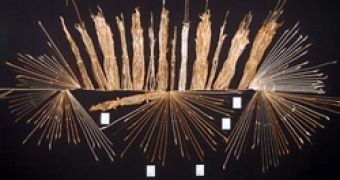Anthropologists at Harvard University have found evidence that ancient Inka accountants shared numbers across their sprawling bureaucratic hierarchy using khipu, aggregations of knotted strings that served to record information in the Andean empire. The finding sheds new light on the uses of khipu, used by Inkans in lieu of the two-dimensional writing favored by other ancient civilizations.
The work is described this week by researchers Gary Urton and Carrie J. Brezine, writing in the journal Science.
The researchers used a computer database developed by Brezine to ascertain that khipu, also known as quipu, may have been used as bureaucratic ledgers. This searchable database, which contains data on nearly half the 650 to 700 extant khipu, can locate patterns in the devices' arrays of 2 to 1,500 knotted strings of varying colors and lengths.
Using the database to analyze 21 khipu gathered at a burial site located at the ancient Inkan administrative center of Puruchuco, on the central Peruvian coast about 11 kilometers northeast of modern-day Lima, Urton and Brezine found that seven of the khipu appeared to contain cumulative numerical data, such as that generated as successive officials compiled sums. The values on the khipu appear to sum upward and subdivide downward, suggesting the addition or subtraction of values as the khipu moved up and down the ranks of the Inka bureaucracy.
Such compilation is consistent with the Inka state's enormous labor hierarchy, wherein groups of 10, 50, 100, 500 and more laborers nestled into increasingly large administrative units. The empire levied tributes in the form of a "labor tax," with each worker required to work a specified number of days each year on state projects and each official required to keep careful records.
"This work gives us some sense of how this complex information was compiled, manipulated, shared and archived in the Inka hierarchy," Urton says. "Instructions of higher-level officials for lower-level ones would have moved, via khipu, from the top of the hierarchy down."
While anthropologists lack the ability to decipher khipu precisely, Urton's previous research has led him to argue that the instruments may also have been used as calendars: Ancient Peruvian burial sites have yielded khipu with 730 strings grouped in 24 sets -- exactly equivalent to the number of days and months in two years.
Softpedia News is conducting this week a poll on OSs. Are you an Apple, Windows or Linux fan? Defend your favorite operating system in the Softpedia News poll.

 14 DAY TRIAL //
14 DAY TRIAL //